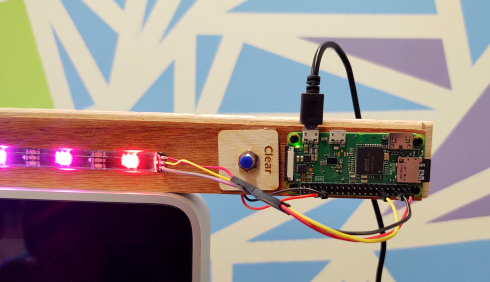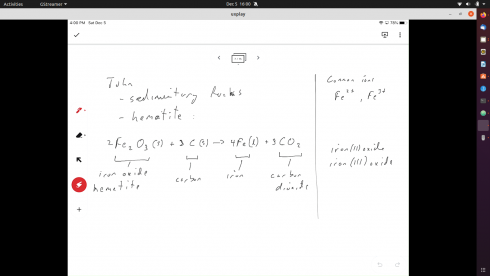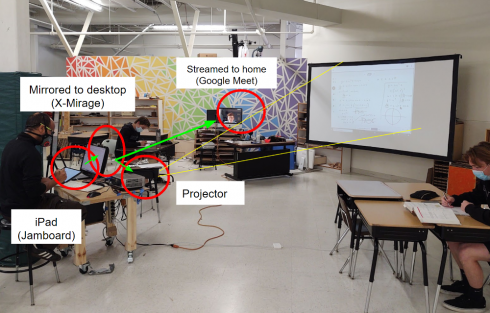I recently rediscovered e-Ink tablets, and ended up getting myself an A6 sized Supernote (Nomad). And I really like it. Despite being someone who has walked around with a gridded, pocket notebook for years, I’ve found that I quickly switched over to taking all of my notes on the tablet. It’s very similar to writing on paper, and the tactile differences are more than made up for by the ability to have multiple notebooks with me at all times, and have them all connected by links. It’s basically my own personal, handwritten wiki: something I wish I’d had for the last 20 years.

Tech in the Classroom: An Argument for e-ink Tablets
My acquisition of this device has coincided with a renewed discussion at our school about the appropriated technology policy for the middle and high schoolers, that is a response to the current movement for retrenching on technology in the classroom, and indeed, banning devices like cell phones in schools. I think these e-ink devices are a qualitatively different category of device that warrant a different approach compared to phones, laptops, and even the more general-purpose tablets like iPads.
What I like:
The type of device I like are the ones specifically designed to be notebooks and not much, or very little, more. Specific highlights:
- Links, links, links: The ability to easily make links from the text/drawing in one note to another page in the note, or another page is the feature that made me opt for the Supernote instead of the other e-ink tablets like the ones from Boox and Remarkable.
- The handwriting and paper-like feel is not like the iPad and similar glass-surfaced tablets, with much less distance from the tip of the pen to the writing on the tablet. The difference between them and pen-and-paper is very small. The Supernote, in particular, foregoes a front light to minimize the pen-to-writing distance. There is evidence that handwriting is better for learning compared to typing (e.g. Ihara et al. 2021), and while they found no significant difference between pen-and-paper and writing on a tablet, I find that the tactile difference is important to me. I’ve not been able to use an iPad for note-taking, though a number of my high-school student do and have continued using them in college.
- The ability to keep all of your notes in one place and on one device is enormous for my students who use the stuff-it-in-the-backpack method of paper organization. It’s not, to my mind, as intuitive and satisfying an organizational method as a binder with sections and color-coded tabs for each subject, but, there are significant number of students who can’t seem to make the binders work. Personally, I’m not using the device as a student, so I need a couple dozen notebooks to keep track of everything I’m doing, and I know, from years of trying, paper has some severe limitations.
- The low refresh rate make them pretty useless for video. This is a big advantage when trying to create a distraction-free environment. This is a result of the way the e-ink technology currently works, and, I think that if this changes as the technology “improves” it will make these devices less appropriate for schools.
- Few distractions, if any: no notifications and limited internet connectivity by design.
- Black and white: This is not necessarily, entirely an unalloyed good, because I know some of my students make extensive use of highlighting in their notes.
- No AI writing assistance: One of my students using the Goodnotes app on an iPad had the unwanted experience of the app trying to answer their math question for them, which I presume is because there’s now an AI in the program. The AI got the question wrong, but it would probably have been worse if it had gotten it right. It seems hard to overstate how problematic it is for the AI to be providing unsolicited answers to a student trying to learn by working through problem sets.
- EMR styluses: These electro-magnetic resonance styluses don’t need charging or pairing with the device, so I’ve been able to use my stylus, which I was using to write on my Supernote, to make marks on my students’ Kindle without having to do anything (it was amazingly satisfying).
Caveats/Uncertainties
- Not all of these devices have open formats for their notes, so there is the non-trivial concern about data loss as proprietary formats evolve or companies go out of business. This is the key issue I have with the Supernote. It is on their road-map, but I’ll continue to be concerned until I actually see it. That said, Max Mujynya has the excellent PySN library of python tools for working with Supernote notes.
- Handwriting to text: This is less relevant in math, at the moment at least, but I’m unsure when this type of text conversion is useful to a student trying to learn English or History, and when it is not.
- Printing and sharing: We’re still figuring out the best way to share notes between devices (especially different companies) given the closed note formats mentioned above.
Since I’ve been using (and gabbing on about) my device constantly, my students have noticed and one of them recently acquired a Kindle Scribe for math class. We’re still figuring out the details about the best way for them to do their and share it with me: right now they’re going to try using a different note for each chapter’s assignments, and submitting the file to me as a pdf. I should be able to mark it up on my device and send a pdf back.
A Note on the Supernote
I’m almost all-in on the Supernote specifically because of its ability to wiki (see above) with the one caveat about the currently closed note file format). But the other feature specifically designed to capture my attention is the fact that it’s built with interchangable parts. You can take the back off and change the battery and the motherboard, which means, hopefully, I can easily upgrade just the motherboard when a better one (X3 perhaps) becomes available. There’s even a slot for a Micro-SD card.

More to follow as we get more experience with the e-ink devices.




